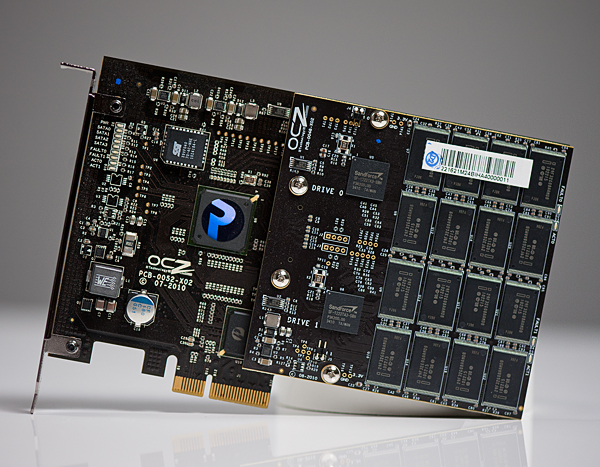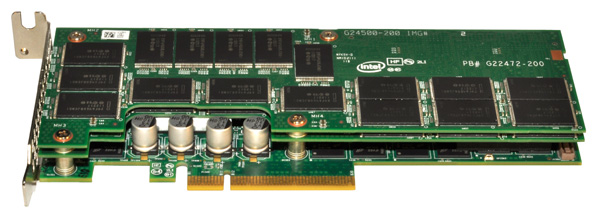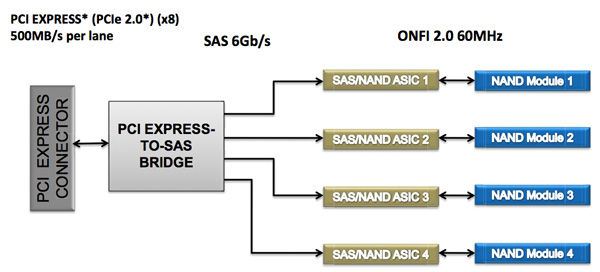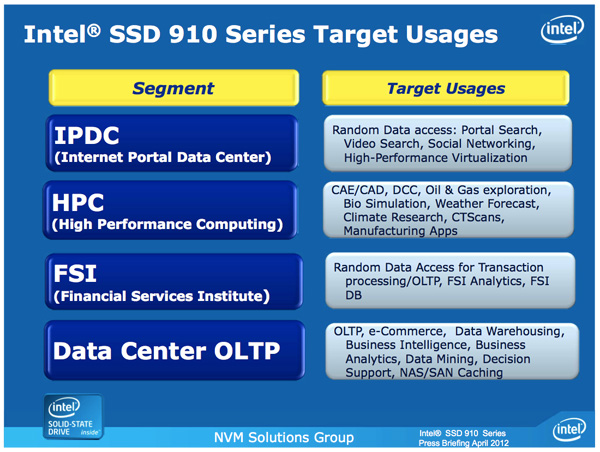Intel's SSD 910: Finally a PCIe SSD from Intel
by Anand Lal Shimpi on April 12, 2012 3:00 AM EST- Posted in
- Storage
- SSDs
- Intel
- Intel SSD 910
Solid state storage has quickly been able to saturate the SATA interface just as quickly as new standards are introduced. The first generation of well-built MLC SSDs quickly bumped into the limits of 3Gbps SATA, as did the first generation of 6Gbps MLC SSDs. With hard drives no where near running out of headroom on a 6Gbps interface, it's clear that SSDs need to transition to an interface that can offer significantly higher bandwidth.
The obvious choice is PCI Express. A single PCIe 2.0 lane is good for 500MB/s of data upstream and downstream, for an aggregate of 1GB/s. Build a PCIe 2.0 x16 SSD and you're talking 8GB/s in either direction. The first PCIe 3.0 chipsets have already started shipping and they'll offer even higher bandwidth per lane (~1GB/s per lane, per direction).
PCI Express is easily scalable and it's just as ubiquitous as SATA in modern systems, it's a natural fit for ultra high performance SSDs. While SATA Express will hopefully merge the two in a manner that preserves backwards compatibility for existing SATA drives, the server market needs solutions today.
In the past you needed a huge chassis to deploy an 8-core server, but thanks to Moore's Law you can cram a dozen high-performance x86 cores into a single 1U or 2U chassis. These high density servers are great for compute performance, but they do significantly limit per-server storage capacity. With the largest eMLC drives topping out at 400GB and SLC drives well below that, if you have high performance needs in a small rackmount chassis you need to look beyond traditional 2.5" drives.
Furthermore, if all you're going to do is combine a bunch of SAS/SATA drives behind a PCIe RAID controller it makes more sense to cut out the middleman and combine the two.

Micron's P320h
We've seen PCIe SSDs that do just that, including several from OCZ under the Z-Drive and RevoDrive brands. Although OCZ has delivered many iterations of PCIe SSDs at this point they all still follow the same basic principle: combine independent SAS/SATA SSD controllers on a PCIe card with a SAS/SATA RAID controller of some sort. Eventually we'll see designs that truly cut out the middlemen and use native PCIe-to-NAND SSD controllers and a simple PCIe switch or lane aggregator. Micron has announced one such drive with the P320h. The NVMe specification is designed to support the creation of exactly this type of drive, however we have yet to see any implementations of the spec.
Many companies have followed in OCZ's footsteps and built similar drives, but many share one thing in common: the use of SandForce controllers. If you're working with encrypted or otherwise incompressible data, SandForce isn't your best bet. There are also concerns about validation, compatibility and reliability of SF's controllers.
Intel's SSD 910
Similar to its move into the MLC SSD space, Intel is arriving late to the PCIe SSD game - but it hopes to gain marketshare on the back of good performance, competitive pricing and reliability.
The first member of the new PCIe family is the Intel SSD 910, consistent with Intel's 3-digit model number scheme.
| Enterprise SSD Comparison | ||||||
| Intel SSD 910 | Intel SSD 710 | Intel X25-E | Intel SSD 320 | |||
| Interface | PCIe 2.0 x8 | SATA 3Gbps | SATA 3Gbps | SATA 3Gbps | ||
| Capacities | 400 / 800 GB | 100 / 200 / 300GB | 32 / 64GB | 80 / 120 / 160 / 300 / 600GB | ||
| NAND | 25nm MLC-HET | 25nm MLC-HET | 50nm SLC | 25nm MLC | ||
| Max Sequential Performance (Reads/Writes) | 2000 / 1000 MBps | 270 / 210 MBps | 250 / 170 MBps | 270 / 220 MBps | ||
| Max Random Performance (Reads/Writes) | 180K / 75K IOPS | 38.5K / 2.7K IOPS | 35K / 3.3K IOPS | 39.5K / 600 IOPS | ||
| Endurance (Max Data Written) | 7 - 14 PB | 500TB - 1.5PB | 1 - 2PB | 5 - 60TB | ||
| Encryption | - | AES-128 | - | AES-128 | ||
The 910 is a single-slot, half-height, half-length PCIe 2.0 x8 card with either 896GB or 1792GB of Intel's 25nm MLC-HET NAND. Part of the high endurance formula is extra NAND for redundancy as well as larger than normal spare area on the drive itself. Once those two things are accounted for, what remains is either 400GB or 800GB of available storage.
The 910's architecture is surprisingly simple. The solution is a layered design composed of two or three boards stacked on one another. The first PCB features either two or four SAS SSD controllers, jointly developed by Intel and Hitachi (the same controllers are used in Hitachi's Ultrastar SSD400M). These controllers are very similar to Intel's X25-M/G2/310/320 controller family but with a couple of changes. The client controller features a single CPU core, while the Intel/Hitachi controller features two cores (one managing the NAND side of the drive while the other managing the SAS interface). Both are 10-channel designs, although the 910's implementation features 14 NAND packages per controller.
In front of the four controllers is an LSI 2008 SAS to PCIe bridge. There's no support for hardware RAID, each controller presents itself to the OS as a single drive with a 200GiB (186GB) capacity. You are free to use software RAID to aggregate the drives as you see fit but by default you'll see either two or four physical drives appear.
The second PCB is home to 896GB of Intel's 25nm MLC-HET NAND, spread across 28 TSSOP packages. The third PCB is only present if you order the 800GB version, and it adds an extra 896GB of NAND (another 28 packages). Even in a fully populated three-board stack, the 910 only occupies a single PCIe slot.
The 910's TDP is set at 25W and requires cooling capable of moving air at 200 linear feet per minute for proper operation.
The use of LSI's 2008 SAS PCIe controller makes sense as there's widespread OS support for the controller, in many cases you won't need to even supply a 3rd party driver. The 910 isn't bootable, but I don't believe that's much of an issue as you're more likely to deploy a server with a small boot drive anyway. There's also no support for hardware encryption, a more unfortunate omission.
Intel's performance specs for the 910 are understandably awesome:
| Intel SSD 910 Performance Specs | ||||
| 400GB | 800GB | |||
| Random 4KB Read (Up to) | 90K IOPS | 180K IOPS | ||
| Random 4KB Write (Up to) | 38K IOPS | 75K IOPS | ||
| Sequential Read (Up to) | 1000 MB/s | 2000 MB/s | ||
| Sequential Write (Up to) | 750 MB/s | 1000 MB/s | ||
Intel's specs come from aggregating performance across all controllers, but you're still looking at a great combination of performance and capacity. These numbers are applicable to both compressible and incompressible data.
The 910 will ship with a software tool that allows you to get even more performance out of the drive (up to 1.5GB/s write speed) by increasing the board's operating power to 28W from 25W.
| Intel SSD 910 Endurance Ratings | ||||
| 400GB | 800GB | |||
| 4KB Random Write | Up to 5PB | Up to 7PB | ||
| 8KB Random Write | Up to 10PB | Up to 14PB | ||
The 910 is rated for up to 2.5PB of 4KB or 3.5PB of 8KB random writes per NAND module (200GB).
The pricing is also fairly reasonable. The 400GB model carries a $1929 MSRP while the 800GB will set you back $3859, both come in below $5/GB. Samples are available today, with the first production of Intel's SSD 910 available sometime in the first half of the year.
| Intel SSD 910 Pricing | ||||
| 400GB | 800GB | |||
| MSRP | $1929 | $3859 | ||
| $ per GB | $4.8225 | $4.8238 | ||
I have to say that I'm pretty excited to see Intel's 910 in action. Intel's reputation as an SSD maker carries a lot of weight in the enterprise market already. The addition of a high-end PCIe solution will likely be well received by its existing customers and others who have been hoping for such a solution.















71 Comments
View All Comments
radium69 - Thursday, April 12, 2012 - link
Can't seem to find it in the article, but what about the warranty?Even Intel consumer SSD's seem to have a good warranty, so I wonder what they can offer for the enterprise market.
$3500 USD for a nice drive is worth considering, don't know about the buying part though.
zdzichu - Thursday, April 12, 2012 - link
90k IOPS doesn't seem to be much. Single SSD can reach 75k-80k already. And milion IOPS F5100 is still untouchable.Sufo - Thursday, April 12, 2012 - link
Why mention the F5100. It's not even vaguely within the same price bracket at around $100/GB.You get 4x the reads and 8x the writes for 23x the price so it's only worth considering if you can afford it and really need it.
Jaybus - Thursday, April 12, 2012 - link
With the exception of the outstanding endurance, the Z-Drive is better performing and only about 20% more expensive. Granted, endurance is very much a factor in its intended market and lower cost always helps.Samus - Thursday, April 12, 2012 - link
I can't believe they left out AES-128 support. Fail.pheadland - Thursday, April 12, 2012 - link
Uh, these are drives intended to be installed in rack-mounted servers in secure machine rooms. They don't need to be encrypted.madmilk - Thursday, April 12, 2012 - link
Is there really a compelling reason for AES support on the drive? I mean, with AES-NI extensions present on all the new Xeons and Opterons, it seems rather redundant.jjj - Thursday, April 12, 2012 - link
Actually it's pretty lame but at least it's cheap for the targeted market.The Micron drive you mention and the Marvell/OCZ native PCI controller sound a lot more interesting.
vol7ron - Thursday, April 12, 2012 - link
1) How does linear feet per minute differ from cubic feet per minute? Linear implies something 2 dimensional, which I'm struggling to understand how it'd be able to cool anything.2) The non-encryption situation may be the largest factor in limited sales, especially if this is targeting the enterprise market.
3) It's nice to see ~1TB drives around the same price as the original mainstream MLC SSD offerings
lukarak - Thursday, April 12, 2012 - link
Well, as i understand it, you could have two cases, one with 100 cubic feet per minute, the other with 200, but because the second case is three times the size, the cooling would be less efficient. Linear measurements are the same for any case size so you can't miss.